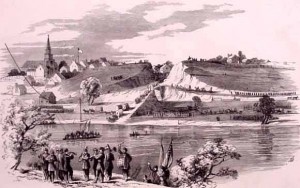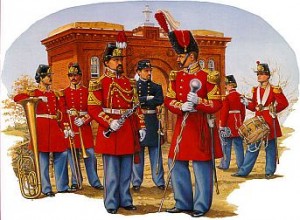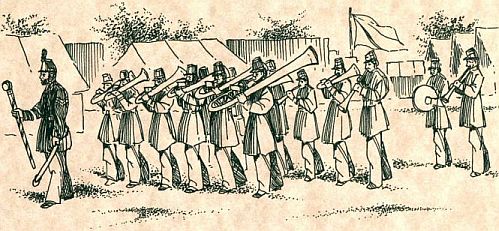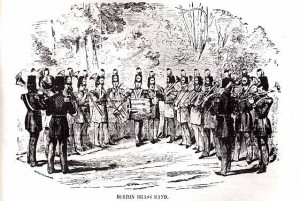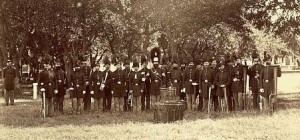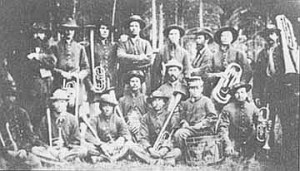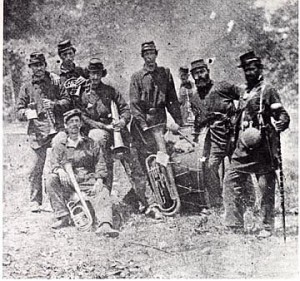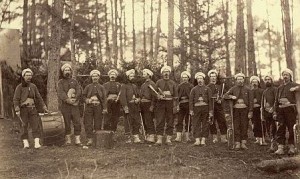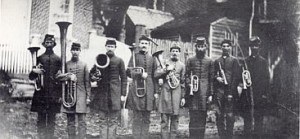Brass Bands of the Civil War
By Jari Villanueva
The roots of the American brass band movement are found in the musical traditions of Western Europe. In the middle of the 18th century there were various types of wind and brass bands in many European towns and cities. These groups performed concerts and various ceremonial duties such as parades and funerals. This band tradition was carried to the New World and found a renewed life in the United States. The Moravians, for example, placed a high value on musical activities, forming bands in the communities where they settled. Their repertoire contained secular as well as religious themes. Military bands were also formed in Philadelphia and Boston by the turn of the 19th century, and the US Marine Band was formed in 1799.
A drawing of a Civil War brass band, serenading the troops
as they cross the river
The US Marine Band at Gettysburg 1863
Development of Brass Band Instruments
At the turn of the 19th century, bands included oboes, clarinets, bassoons and drums, as brass instruments of the time were limited to the notes of the overtone series. With innovations made in the early part of the 19th century, brass cross between a saxophone and a bugle. This innovation proved popular and extended the use of brass instruments, it eventually replaced the keyed bugle. An instrumental piece written in 1835, Wood Up Quickstep was composed by John Holloway (dates unknown). The piece became closely associated with Edward “Ned” Kendall (1808-61) who was a virtuoso on the keyed bugle in the days before valved cornets. Despite the invention of valves, Kendall continued to play the keyed bugle all his life. In 1856, he took part in a famous contest with himself on the keyed bugle playing against Patrick Gilmore on the valved cornet. The contest, which consisted of the two soloists playing sections of Wood Up Quickstep after each other, ended in a tie of virtuosity for both men. However, it sounded the death knell for the keyed bugle and signaled the rise of the valved cornet. Although these new instruments were integrated into wind bands, all-brass bands ensembles. These all-brass bands grew in popularity and soon bands were to be found in all parts of the country.
One style of instrument associated with the brass bands was the over-the-shoulder (OTS) Saxhorn (named for its inventor, Adolph Sax). The distinguishing characteristic of these horns was the bell that pointed towards the rear so troops marching behind the band could hear the music.
On Dress Parade
Brass Band Formation
Brass Bands were formed of fraternal organizations, militia groups, police and firemen associations and professional guilds. The Boston Brass Band, American Brass Band, Dodworth Saxhorn Band and Salem Brass Band are a few of the brass bands that were formed. By 1850 these bands were well established, as seen not only by concert programs and pre-war America as brass bands flourished throughout the country. An example of these collections was The Musicians Companion, compiled by Elias Howe Jr. of Boston and arranged by J. H. Seipp and A. F. Knight of the Boston Brigade Band. Marches, quicksteps, waltzes, polkas, schottisches and more were arranged for various groups of instruments ranging in size from 5-10 musicians.
The Boston Brass Band
Post Band at Ft. Monroe, VA in 1864. According to Ken Rose, LTC (Ret.), former commander of The
U.S. Continental Army Band at Ft. Monroe, these are probably the musicians of the 3rd Pennsylvania
Artillery, which was stationed at Ft. Monroe from 1862-65. On the large side for a regimental band,
this band appears to have more than 20 musicians, including two with clarinets!
Military Bands
At the start of the Civil War there were few military bands. The few that did exist included the US Marine Band, The US Military Academy Band, several Regular Army regimental bands, and bands associated with state militias. The better known of the latter included the 7th New York Regimental Band led by Claudio Grafulla and the 24th Massachusetts Regimental Band led by Patrick Gilmore. Militia bands were very highly valued by the local militias as they participated in musters, ceremonies and parades and were useful in recruiting soldiers. As state and local militias were mustered into service they naturally brought along their bands. Within a few months of the start of the war, Congress authorized the creation of Regimental bands for the Regular Army. The War Department General Order no. 48 issued on 31 July 1861 entitled 2 field musicians (buglers or fifes and drummers) per company of soldiers and a band of 16-24 musicians for each regiment. This led to the formation of hundreds of bands and the enlistment of thousands of musicians whose duties were solely to provide music for the Army. The musicians were considered noncombatants and had few duties outside their musical ones. These brass bands played a significant role in the life of soldiers. They were the pride of their units and it was acknowledged that they provided the morale boosting so badly needed. Many letters from soldiers of the time attest to their appreciation of good band music.
The band of the 24th Michigan
By the end of 1861, the Federal Government, experiencing financial difficulties brought on by the war and realizing it could no longer support so many bands on the Regimental level, abolished Regimental bands but provided for 16-piece bands at the Brigade level (a Brigade is made up of four or more Regiments). Some of the bands were reformed into Brigade bands and the quality of music improved. Despite the abolition of bands, some Regiments were able to retain their groups by having the musicians re-enlist as combatants and then assigning the men to musical duties.
Rhode Island Band
114th PA Band
The band of the 26th North Carolina, CSA, in Salem, NC 1862
Purpose For Brass Bands
The music provided by bands during the war did much to help the cause. The bands found their services much in demand for serenades (concerts), playing for troops on the march, at ceremonies and civic functions; they entertained them in parks and in the concert hall; they provided the music for their balls and dances. Playing for dress parades and reviews was important in military life as the dress parade provided a test of military efficiency and training. Some bands actually found themselves in the middle of battle, playing during the fighting! Duties of bandsmen were also expanded to battlefield chores of serving as stretcher bearers and assisting in medical operations such as amputations. The music played an important part in the daily lives of soldiers. Tunes like Battle Hymn of The Republic, Rally Round The Flag, and Yankee Doodle inspired patriotic fervor, while We’re Tenting Tonight, Aura Lea, and Home Sweet Home reminded the men of home.
There were bands in the Confederate Army also. General Robert E. Lee realized the importance of music to the morale and welfare of his men. He stated “I don’t believe we can have an army without music,” and although no one is sure how many bandsmen served with the Confederate Army, music was very important to the Southern cause. Songs like Dixie, God Save The South, and Maryland, My Maryland were as important to the Southern cause as their counterparts in the North.
Find Music for Civil War brass bands which has been transcribed for Brass Quintet
by Jari Villanueva.
Did you enjoy this article? You may be interested in our article about brass band music of the Civil war also.
You also can find limited selections of brass band arrangements here, and also at Sheet Music Plus.

